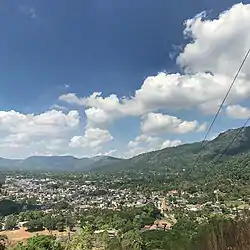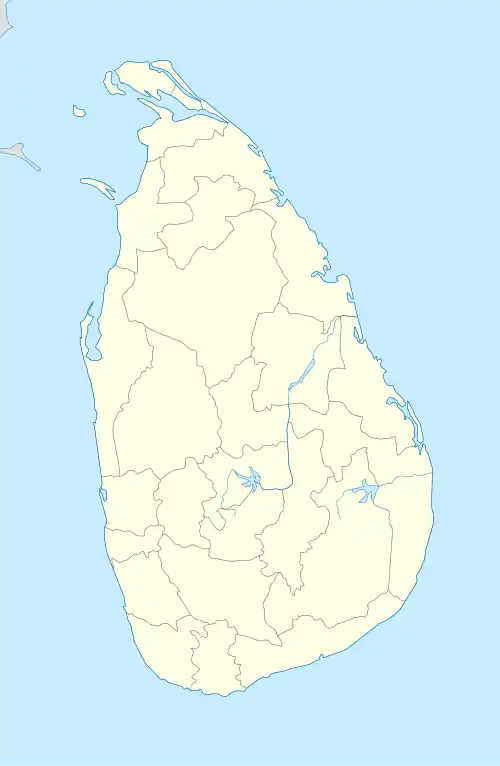Matale
Matale (Tamil: மாத்தளை, romanized: Māttaḷai) often written as Mathalai is a large regional city located at the heart of the Central Hills of the island lies in a broad, fertile valley at an elevation of 364 m (1,194 ft) above sea level. It is the administrative capital and largest city of Matale District, Central Province, Sri Lanka. It is 142 kilometres (88 mi) from Colombo and near Kandy. Surrounding the city are the Knuckles Mountain Range, the foothills were called Wiltshire by the British.
Matale
மாத்தளை | |
|---|---|
| Matale | |
 City skyline view from Sindakatti Sri Kumaran Kovil. | |
 Matale | |
| Coordinates: 7°28′7″N 80°37′22″E | |
| Country | Sri Lanka |
| Province | Central Province |
| District | Matale District |
| Divisional Secretariat | Matale Division |
| Mathula Colony | 4th century |
| Matale Municipal Council | 1963 |
| Founded by | King Pandukabhaya |
| Government | |
| • Type | Mayor-Council |
| • Body | Matale Municipal Council |
| • Mayor | His Worship, Hon. Sandhanam Prakash CWC[1] |
| Area | |
| • City | 70.0 km2 (27.03 sq mi) |
| • Urban | 25.65 km2 (9.90 sq mi) |
| • Metro | 71 km2 (27 sq mi) |
| Elevation | 364 m (1,194 ft) |
| Population (2016) | |
| • Density | 1,490/km2 (3,900/sq mi) |
| • Urban | 38,229 (Municipality Area) |
| • Metro | 78,864 (Matale Division) |
| Demonym(s) | Mathalites |
| Time zone | UTC+5:30 (Time in Sri Lanka) |
| • Summer (DST) | UTC+5:30 (not observed) |
| Postal code | 21xxx |
| Area code(s) | 066 |
History
Matale is the only district of Sri Lanka, where an ancient book of written history is found. It is known as Pannagamam - பன்னாகமம் ("Five Headed Serpent" in English) of Goddess Muthumari in Sri Muthumariamman Temple, Matale.
The second comes the Aluvihare Rock Temple that is situated on north side of the city's suburb, Aluvihare. The historic location where the Pali Canon was written down completely in text on ola (palm) leaves in 29 BCE.
Christ Church, Matale was consecrated by Bishop James Chapman on 30 December 1860. The church site chosen was Fort McDowall, commanding a view of the entrance to Matale via Trincomalee. The church having been erected and furnished, the Revd William Frederick Kelly, Minister and Chaplain in Matale, and 36 others sent their petition to the Rt Revd James Chapman, D.D., to dedicate and consecrate Christ Church. The parsonage was opened on 16 August 1862. The 75th Anniversary was celebrated in 1935. The centenary was celebrated on 28 and 29 January 1961. The 125th Anniversary was celebrated on 6 September 1986. The church was gutted by fire in 1985 and was completely restored. Services were held in the Baptist Church in the interim period. On 22 June 1911, there was a special service held in this church in connection with the Coronation of His Majesty King George V, and Queen Mary. The offertory on that was given to the King Edward VIII.[2] The church's 150th Anniversary was celebrated on 2 October 2010.
Matale was the site of a major battle in 1848 when the Matale Rebellion started and the British garrison in the Fort MacDowall in Matale was placed under siege by the rebels led by Weera Puran Appu and Gongalegoda Banda.
The city is also the birthplace of Monarawila Keppetipola, a rebel who led the Wellasa rebellion against the British troops. His ancestral home, Kappetipola walawuwa, still exists at Hulangamuwa, Matale.
Attractions
- Nandamithra Ekanayake International Hockey Ground
- Weera Puranappu Monument
- Weera Monarawila Keppetipola Monument
- Anagarika Dharmapala monument
- Aluvihare Rock Temple
- Matale Sri Muthumariyamman Temple
- Knuckles Mountain Range
- Fort MacDowall
- Matale clock tower
- Matale railway station, the former terminus of the Colombo railway (completed in 1880)
Economy
The city is surrounded by large plantations and is famous for its spice gardens. In addition to agriculture, the city's main economic activities include Tourism, Business and Trade. Population growth, urban expansion and economic development in Matale have created regulatory and management challenges.[3] Resident's of Municipality Enjoys Urban life in Matale Municipal Council Area (MMCA) [4][5]
Education
Matale is home to some of the island's oldest and leading colleges and schools.
- Zahira College, Matale.
- St. Thomas' College, Matale.
- St. Thomas' Girls' School, Matale.
- Government Science College, Matale.
- Amina Girl's National School, Matale.
- Christ Church College, Matale.
- Matale Hindu College, Matale.
- Sri Sangamitta Balika National School, Matale.
- Vijaya College, Matale.
- Vijayapala Collage, Matale.
- Pakkiyam National School, Matale.
- Bms College, Matale.
- Royal English School Matale.
- Matale International School.
- Greenwood College International, Matale.
- Technical College Matale.
Demographics
The population of the Matale Municipality areas is mix of numerous ethnic groups. The Sinhalese make the majority in Matale. Muslims are the second largest group in the city. Others include Sri Lankan Tamils, small numbers of Indian Tamils, Burgher and Malay.
Ethnicity according to Matale urban area (2007)
Source:statistics.gov.lk
Ethnicity according to Matale division area (2012)
Source:statistics.gov.lk
Suburbs
Notable personalities
- Ven. Premananda, was a Sri-Lankan born Indian Hindu guru
- William Gopallawa, was the last Governor-General of Ceylon and first president of Republic of Sri Lanka.
- Kingsley Jayasekera, was a prominent actor & a singer.
- Hemal Ranasinghe, prominent actor.
- Kumar Sangakkara, International Sri Lankan cricketer
- Chanaka Welegedara, International Sri Lankan cricketer.
- Prabath Jayasuriya, International Sri Lankan cricketer.
- A. S. Jayawardena, Governor Central Bank of Sri Lanka.
- Richard Aluwihare, First Ceylonese Inspector General of Police.
- Alexander Udugama, First Sinhalese Catholic Army Commander.
- Ehelepola Nilame, a minister in King Sri Vikrama Rajasinha's royal court.
- Keppetipola Disawe, was a prominent leader of the Great Rebellion of Uva in 1818.
- Lt Gen. Shavendra Silva, Commander of the 58 Division during the Sri Lankan Civil War. He is the current Commander of the Sri Lanka Army.
References
- https://ceylontoday.lk/news/post-of-matale-mayor-daljith-aluvihare-suspended-with-immediate-effect
- Anti Tuberculosis Fund. (Ref. Ceylon Churchman Report for the year ending 20 June 1911)
- Gamage, Nardda; Kumara, Sisira (31 December 2016). "Socio-Economic Determinants of Well-Being of Urban Households: A Case of Sri Lanka". Rochester, NY. SSRN 2938379. Cite journal requires
|journal=(help) - Atapattu, A; Subasinghe, Shyamantha; Iwai, Y (24 August 2019). "Urban Growth and Development Pattern of Matale Municipal Council Area". Cite journal requires
|journal=(help) - Gamage, Nardda; Kumara, Sisira (31 December 2016). "Socio-Economic Determinants of Well-Being of Urban Households: A Case of Sri Lanka". Rochester, NY. SSRN 2938379. Cite journal requires
|journal=(help)
External links
| Wikimedia Commons has media related to Matale. |
